TOYOTA SEQUOIA 2020 Owners Manual (in English)
Manufacturer: TOYOTA, Model Year: 2020, Model line: SEQUOIA, Model: TOYOTA SEQUOIA 2020Pages: 588, PDF Size: 12.33 MB
Page 311 of 588

3114-5. Using the driving support systems
4
Driving
SEQUOIA_OM_USA_OM0C021U_20MY
■Automatic leveling function
Regardless of the number of occupants or the luggage load, vehi cle height in
any mode is always adjusted to a fixed height by the automatic leveling func-
tion.
■ When “HI” mode is selected
The vehicle height will change to “N” mode when driving at the speeds of
18 mph (30 km/h).
■ When “LO” mode is selected
●The vehicle height will change to “N” mode when vehicle speed e xceeds
7 mph (12 km/h).
● This mode allows for easy access to the vehicle (getting in and out) and
easy loading and unloading.
■ The electronically modulated air suspension will not operate in the fol-
lowing cases:
● The underbody of the vehicle is touching the surface of the roa d.
● The area around the suspension is covered with ice.
The height control indicators will blink, turn off and then turn on continuously
to indicate that the electronically modulated air suspension is not operational.
To re-enable operation, turn off the engine and then restart it .
■ Even if you hear an operating noise
This does not indicate a problem in the electronically modulate d air suspen-
sion.
■ The electronically modulated air suspension failure warning
The warning message is displayed on the multi-information displ ay, and the
electronically modulated air suspension cannot be activated unt il the malfunc-
tion is corrected.
Stop the engine and start again. If the warning message turns off, the system
operating correctly. If the warning message continues to be displayed, have
your vehicle inspected by your Toyota dealer as soon as possibl e.
Page 312 of 588

3124-5. Using the driving support systems
SEQUOIA_OM_USA_OM0C021U_20MY
WARNING
■The electronically modulated air suspension must be turned off in the
following circumstances:
Otherwise, the automatic leveling function may cause the vehicl e’s height to
change, and you may catch part of your body in the vehicle, res ulting in an
unexpected accident:
● When driving through water such as shallow streams (Put the veh icle
height in “HI” mode and turn off the electronically modulated a ir suspen-
sion. Drive at 18 mph [30 km/h] or slower.)
● When jacking up the vehicle, installing tire chains or tying th e vehicle with
chains/wires for transportation via flat bed truck (Turn the sy stem to the
manual mode and stop the engine.)
● When the vehicle must be towed (Put the vehicle height in “N” mode and
turn the system to the manual mode.)
● When the vehicle gets stuck (Turn the system to the manual mode .)
● When disconnecting a trailer (Put the vehicle height in “N” mod e and turn
the system to the manual mode.)
■ Selecting the correct height mode
Observe the following precautions to prevent accidents.
Failure to do so may cause damage to parts of the vehicle, as w ell as dan-
gerous handling characteristics, which may lead to fatal or injury accidents.
● Before you lower the vehicle’s height, check under the vehicle to make
sure that no one is there.
● “HI” mode should only be used when driving on rough roads, for example
when driving off-road.
Because the vehicle’s center of gravity will become higher when in the
mode, the vehicle may become unstable when turning abruptly, re sulting
in an accident.
● Do not select “HI” mode when you load cargo on the roof luggage carrier.
Because the vehicle’s center of gravity will become higher when in the
mode, the vehicle may become unstable when turning abruptly, re sulting
in an accident.
Page 313 of 588

3134-5. Using the driving support systems
4
Driving
SEQUOIA_OM_USA_OM0C021U_20MY
NOTICE
■Be careful in any place where overhead space is limited.
When changing to a higher mode or after unloading, the vehicle height will
rise. This may cause damage to the vehicle.
■ Do not select “LO” mode when driving on bumpy roads.
If the underbody of the vehicle touches a rugged road surface, the vehicle
may be damaged.
■ Do not change the vehicle height frequently.
The compressor might overheat and cause the operation to stop.
■ When on the extremely uneven roads with rocks
Sometimes the vehicle height is not adjusted because it is judg ed as
uneven road driving.
Page 314 of 588
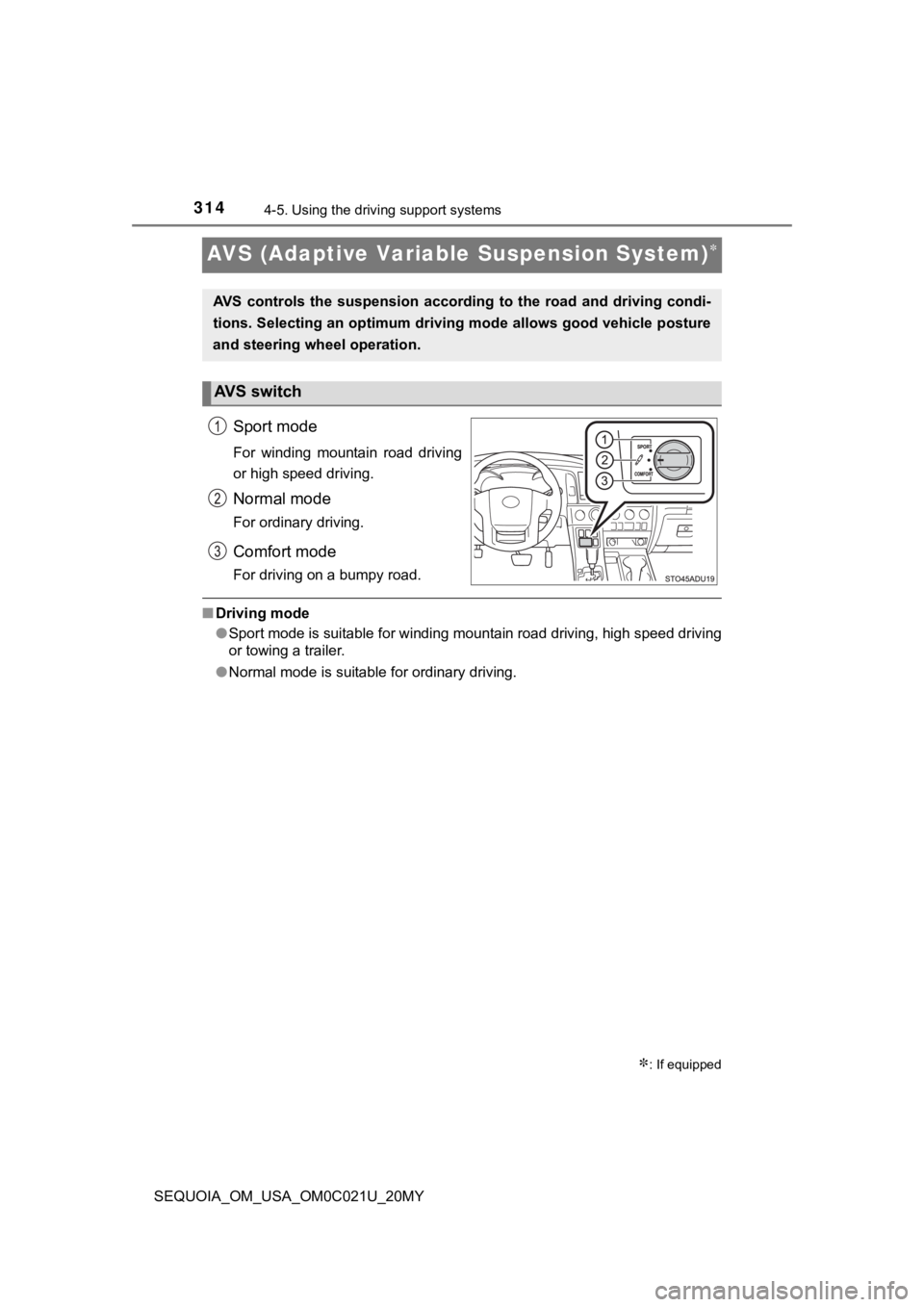
3144-5. Using the driving support systems
SEQUOIA_OM_USA_OM0C021U_20MY
AVS (Adaptive Variable Suspension System)
Sport mode
For winding mountain road driving
or high speed driving.
Normal mode
For ordinary driving.
Comfort mode
For driving on a bumpy road.
■Driving mode
●Sport mode is suitable for winding mountain road driving, high speed driving
or towing a trailer.
● Normal mode is suitable for ordinary driving.
: If equipped
AVS controls the suspension accord ing to the road and driving condi-
tions. Selecting an optimum drivi ng mode allows good vehicle posture
and steering wheel operation.
AVS switch
Page 315 of 588
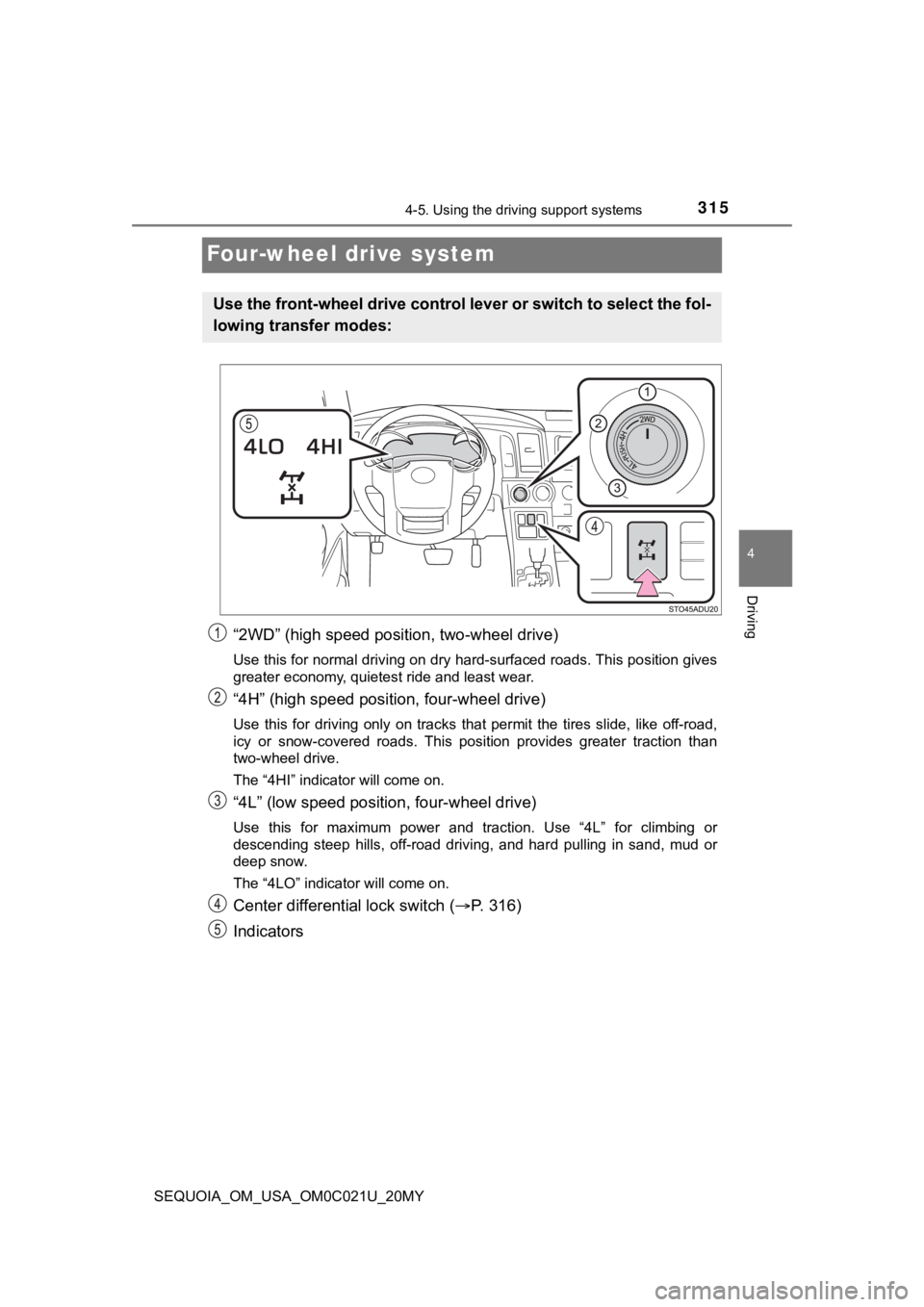
3154-5. Using the driving support systems
4
Driving
SEQUOIA_OM_USA_OM0C021U_20MY
Four-wheel drive system
“2WD” (high speed position, two-wheel drive)
Use this for normal driving on dry hard-surfaced roads. This position gives
greater economy, quietest ride and least wear.
“4H” (high speed position, four-wheel drive)
Use this for driving only on tracks that permit the tires slide , like off-road,
icy or snow-covered roads. This position provides greater tract ion than
two-wheel drive.
The “4HI” indicator will come on.
“4L” (low speed position, four-wheel drive)
Use this for maximum power and traction. Use “4L” for climbing or
descending steep hills, off-road driving, and hard pulling in s and, mud or
deep snow.
The “4LO” indicator will come on.
Center differentia l lock switch (P. 316)
Indicators
Use the front-wheel drive control lever or switch to select the fol-
lowing transfer modes:
Page 316 of 588
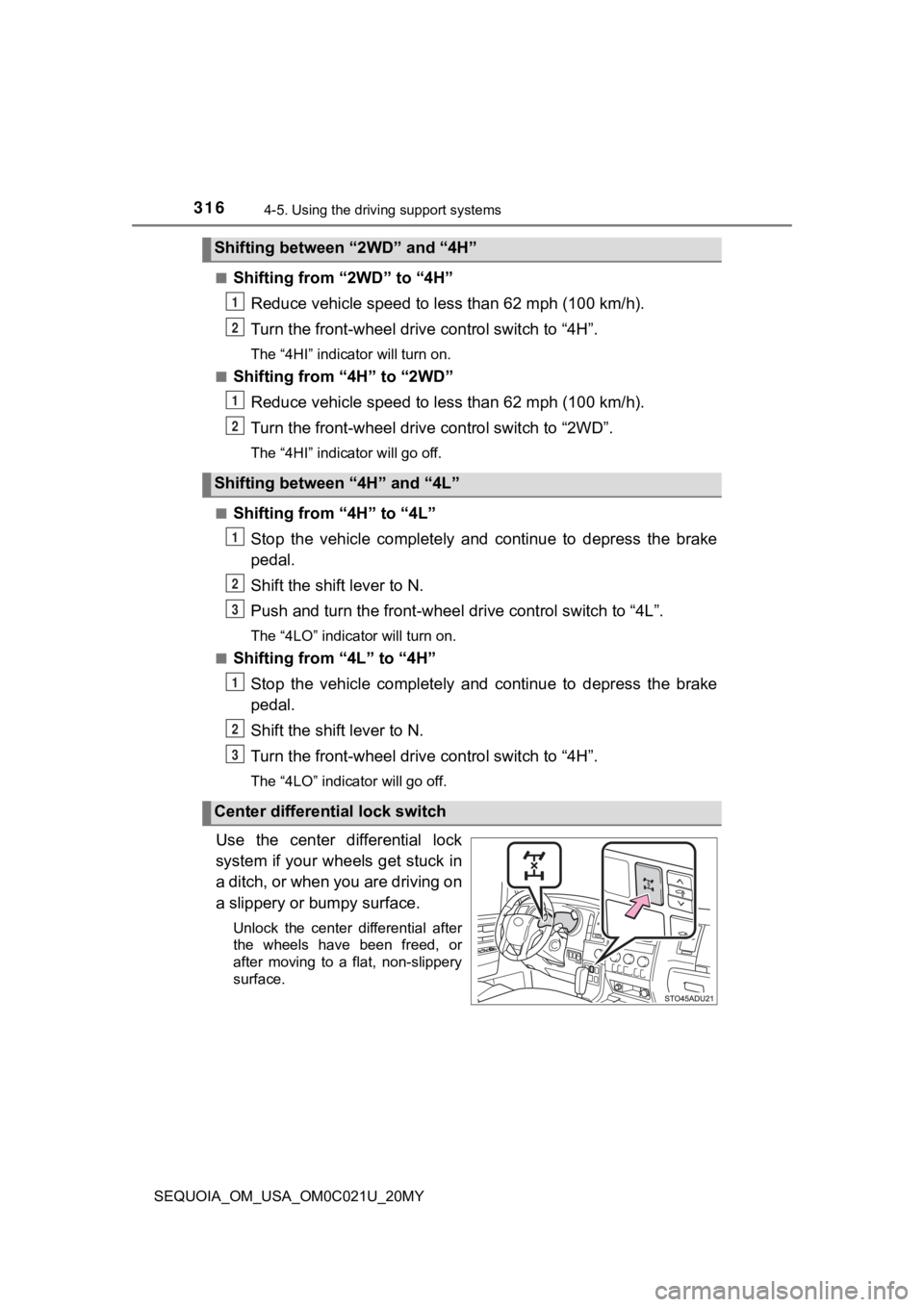
3164-5. Using the driving support systems
SEQUOIA_OM_USA_OM0C021U_20MY■
Shifting from “2WD” to “4H”
Reduce vehicle speed to less than 62 mph (100 km/h).
Turn the front-wheel drive control switch to “4H”.
The “4HI” indicator will turn on.
■
Shifting from “4H” to “2WD”
Reduce vehicle speed to less than 62 mph (100 km/h).
Turn the front-wheel drive control switch to “2WD”.
The “4HI” indicator will go off.
■
Shifting from “4H” to “4L” Stop the vehicle completely and continue to depress the brake
pedal.
Shift the shift lever to N.
Push and turn the front-wheel drive control switch to “4L”.
The “4LO” indicator will turn on.
■
Shifting from “4L” to “4H”
Stop the vehicle completely and continue to depress the brake
pedal.
Shift the shift lever to N.
Turn the front-wheel drive control switch to “4H”.
The “4LO” indicator will go off.
Use the center differential lock
system if your wheels get stuck in
a ditch, or when you are driving on
a slippery or bumpy surface.
Unlock the center differential after
the wheels have been freed, or
after moving to a flat, non-slippery
surface.
Shifting between “2WD” and “4H”
Shifting between “4H” and “4L”
Center differential lock switch
1
2
1
2
1
2
3
1
2
3
Page 317 of 588

3174-5. Using the driving support systems
4
Driving
SEQUOIA_OM_USA_OM0C021U_20MY
■Shifting between “2WD” and “4H”
●When the ambient temperature is 5.0 °F (-15 °C) or lower, shifting from
“2WD” to “4H” cannot be performed with the vehicle speed above 43 mph
(70 km/h).
● If the “4HI” indicator does not go off when you shift from “4H” to “2WD”, drive
straight ahead while accelerating or decelerating, or drive in reverse.
■ Front-wheel drive usage frequency
You should drive in front-wheel drive for at least 10 miles (16 km) each
month.
This will assure that the front drive components are lubricated .
■ The center differential lock switch can be operated when
●The front-wheel drive control switch is in the “4H” or “4L” pos ition.
● The vehicle speed is less than 62 mph (100 km/h)
■ Center differential lock system
●When the front-wheel drive control switch is in the “4L” positi on and the cen-
ter differential is locked, the VSC is automatically turned off .
● When the front-wheel drive control switch is turned to the “2WD ” position,
the center differential is automatically unlocked.
● If the operation is not completed, the center differential lock indicator blinks.
If the indicator does not go off when unlocking the center diff erential, drive
straight ahead while accelerating or decelerating, or drive in reverse.
Page 318 of 588

3184-5. Using the driving support systems
SEQUOIA_OM_USA_OM0C021U_20MY■
If the “4LO” indicator, “4HI” indicator or the center different ial lock indi-
cator blinks
● If the “4LO” indicator continues to blink when shifting between “4H” and “4L”,
stop the vehicle completely, move the shift lever to N and oper ate the switch
again.
● If the shift lever is moved before the “4LO” indicator turns on /off, the transfer
mode may not be shifted completely. The transfer mode disengage s both
the front and rear driveshafts from the powertrain and allows the vehicle to
move regardless of the shift position. (At this time, the indic ator blinks and
the buzzer sounds.)
Therefore, the vehicle is free to roll even if the automatic tr ansmission is in
P. You or someone else could be seriously injured. You must complete the
shifting of the transfer mode.
To complete the shifting, stop the vehicle completely, return t he shift lever to
N, and confirm that the shift was completed (The indicator turn s on/off).
● If the engine coolant temperature is too low, transfer mode may not be able
to shift. When the engine is warmer, turn the switch again.
If the “4LO” indicator, “4HI” i ndicator or the center different ial lock indicator
continues to blink even after attempting the above, there may b e a malfunc-
tion in the engine, the brake system or the four-wheel drive sy stem. In this
case, you may not be able to shift between “2WD” and “4H”, “4H” and “4L”,
and the center differential lock may not be operable. Have the vehicle
inspected by your Toyota dealer immediately.
■ Shifting to the “4L” position
The VSC off indicator will come on.
If the center differential is locked, VSC is automatically turn ed off.
Page 319 of 588
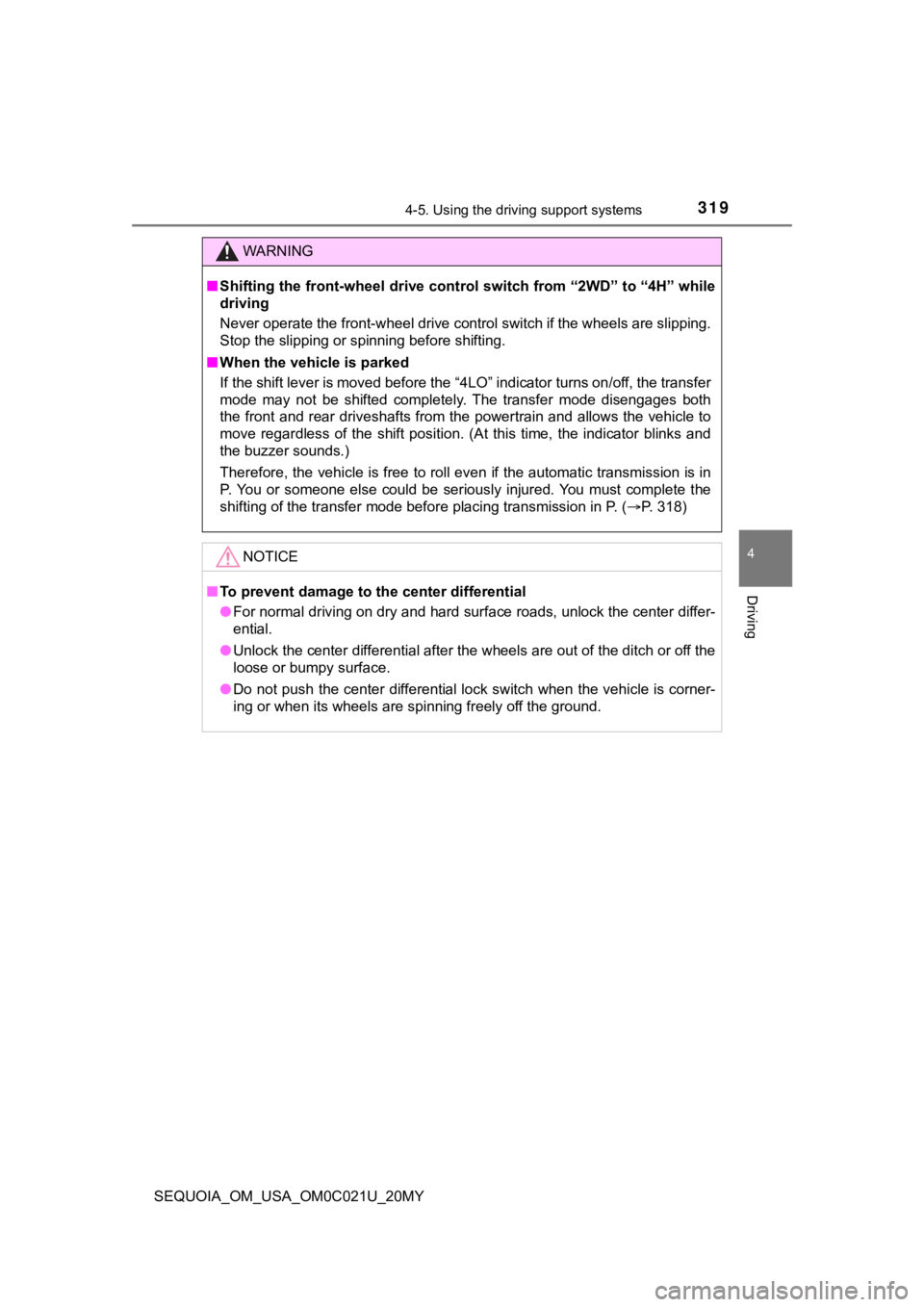
3194-5. Using the driving support systems
4
Driving
SEQUOIA_OM_USA_OM0C021U_20MY
WARNING
■Shifting the front-wheel drive control switch from “2WD” to “4H ” while
driving
Never operate the front-wheel drive control switch if the wheel s are slipping.
Stop the slipping or spinning before shifting.
■ When the vehicle is parked
If the shift lever is moved before the “4LO” indicator turns on/off, the transfer
mode may not be shifted completely. The transfer mode disengage s both
the front and rear driveshafts from the powertrain and allows t he vehicle to
move regardless of the shift position. (At this time, the indic ator blinks and
the buzzer sounds.)
Therefore, the vehicle is free to roll even if the automatic tr ansmission is in
P. You or someone else could be seriously injured. You must com plete the
shifting of the transfer mode before placing transmission in P. (P. 318)
NOTICE
■ To prevent damage to the center differential
● For normal driving on dry and hard surface roads, unlock the ce nter differ-
ential.
● Unlock the center differential after the wheels are out of the ditch or off the
loose or bumpy surface.
● Do not push the center differential lock switch when the vehicl e is corner-
ing or when its wheels are spinning freely off the ground.
Page 320 of 588
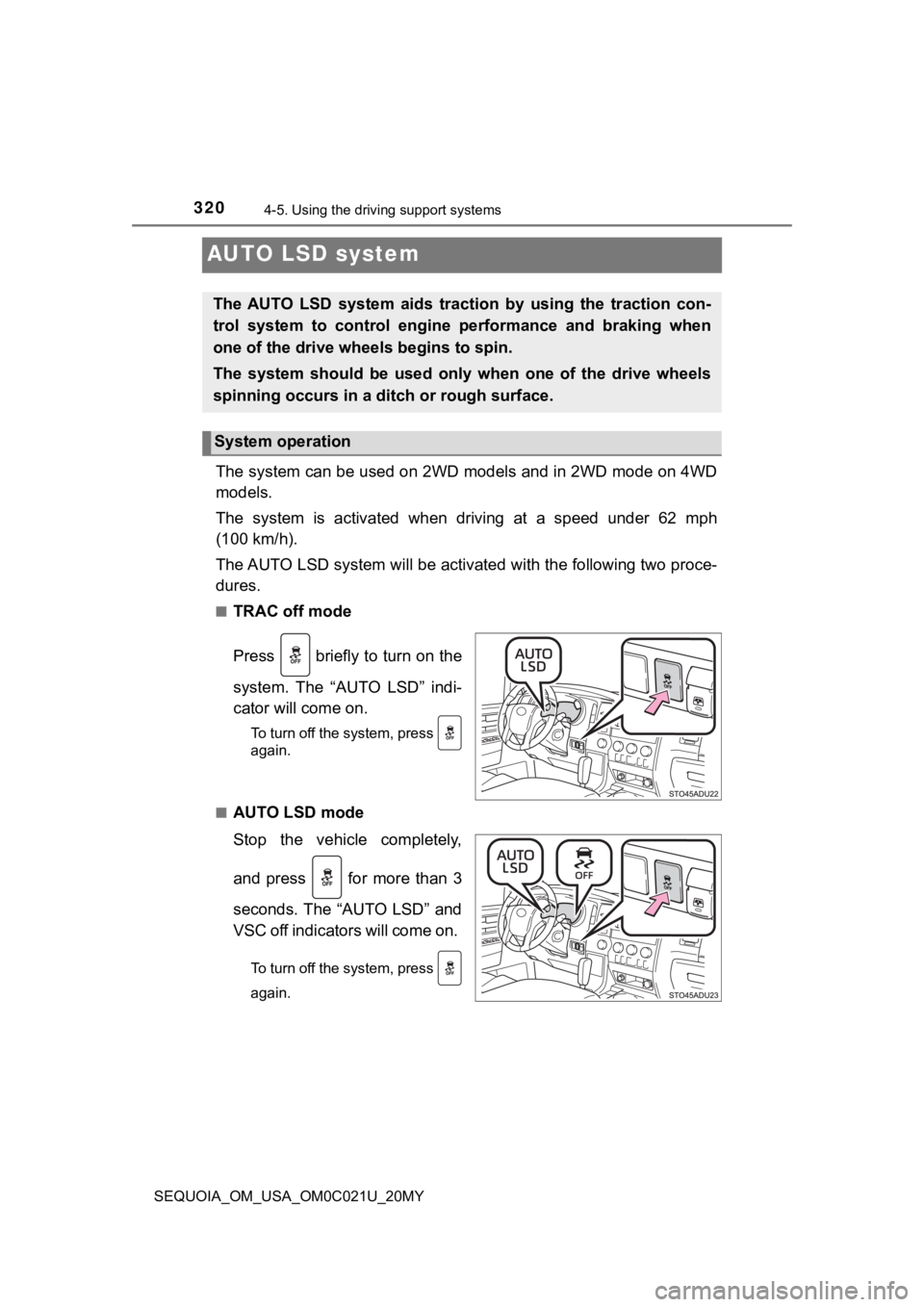
3204-5. Using the driving support systems
SEQUOIA_OM_USA_OM0C021U_20MY
AUTO LSD system
The system can be used on 2WD models and in 2WD mode on 4WD
models.
The system is activated when driving at a speed under 62 mph
(100 km/h).
The AUTO LSD system will be activated with the following two pr oce-
dures.
■TRAC off mode
Press briefly to turn on the
system. The “AUTO LSD” indi-
cator will come on.
To turn off the system, press
again.
■
AUTO LSD mode
Stop the vehicle completely,
and press for more than 3
seconds. The “AUTO LSD” and
VSC off indicators will come on.
To turn off the system, press
again.
The AUTO LSD system aids trac tion by using the traction con-
trol system to control engine performance and braking when
one of the drive wheels begins to spin.
The system should be used only when one of the drive wheels
spinning occurs in a ditch or rough surface.
System operation